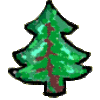Shoots woody, irregularly branched, branches bearing leaves in lax or crowded spirals. Wood pycnoxylic. Leaves linear or cuneate, only slightly spreading, simple, forked or multifid, trifacial or bifacial, leaves or leaf segments with a median vein mesophyll in transverse plates. Leaf base decurrent. Stomata haplocheilic, monocyclic or partly amphicyclic. Fertile parts of shoots bearing laterally attached solitary stalked ovules. Ovule anatropous, platyspermic. Body of seed oval with two prominent lateral carineae in principal plane and two low ridges in secondary plane. Chalazal end broadly rounded, micropylar end tapering. Stalk of seed attached in the principal plane, micropyle situated between stalk and opposite horn-like upward prolongation of integument. Integument stony, free from nucellus, internally cutinized. Nucellus with a robust outer cuticle, receiving pollen in its fimbrate apex. Megaspore membrane not cutinized. Pollination typically by Ginkgocycadophytus type of pollen grains.
Buriadia Seward & Sahni
nomenclatorial act:
emend.
Bibliography:
Page:
39
diagnosis:
systematic position:
... may either mean that Buriadia is an unusual conifer or that it is unclassifiable amongst the presently known groups of the gymnosperms.
typeseries:
TYPE SPECIES. Buriadia heterophylla (Feistmantel) Seward & Sahni
Classification:

Add new comment